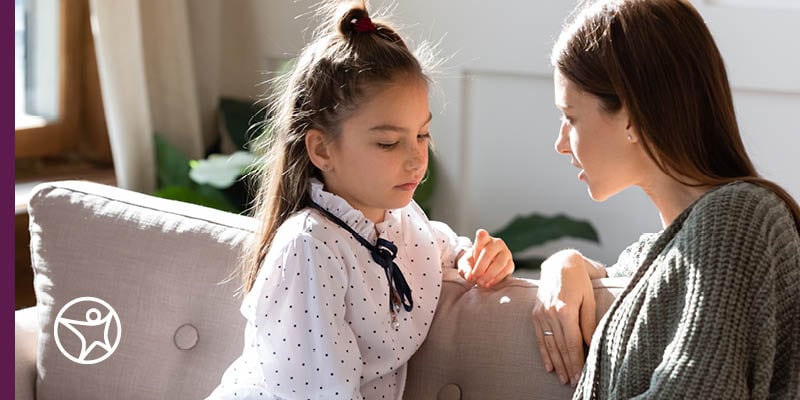Setting Healthy Screen Time Limits for Students Learning Online
by Julie Hersum
byConnections Academy
7 min to readMay is Mental Health Awareness Month and the perfect time to talk to your child about their mental health. In particular, if your otherwise social child is withdrawing from social situations or experiencing loneliness, especially if they have recently started learning at home. Whether it be introversion or something more serious, socially isolating can be difficult to identify and handle for young people.
Feeling lonely and being alone are two different states of being. One is not always in our control while the other is a choice.
While some children are naturally quiet and adapt well to challenges in their lives such as increased stress, or changes in social dynamics, some are not aware of how to address these feelings in a healthy way and may turn to isolating themselves as a way to cope.
If your child spends a lot of time alone, you may be wondering if their behavior is healthy for them or if they need help—particularly if you’re worried they’re withdrawing from engagement in online school. In order to understand the difference between needing some extra space to mentally recharge and withdrawing from the world, we first need to explore how introversion and isolation are different.
If you’re worried your child is experiencing loneliness in school, you naturally want to help them. To do that, you need to understand the two distinct situations they may be facing: introversion or isolation. Learning the basic differences can be a great aid in assisting your child.
Introversion is an ingrained personality trait, while isolation is the process of secluding oneself from others. Isolation can be the result of underlying or emerging psychological, emotional, and/or physiological factors, but to fully understand the difference, you need to first understand how students often manifest introversion versus isolation.
School-aged children and adolescents who are introverts prefer to stay alone and yet still engage with peers who share similar interests/hobbies, forming soulful, emotional bonds. They tend to get away from social gatherings to focus on self-discovery, hone their skills, reconnect within, and recharge.
On the other hand, children who isolate do it because they feel that’s the only safe choice. It’s a flight response they have developed to stressors like failure, rejection, and bullying in their life. The consequences for children who socially withdraw aren’t positive. Such children often feel lonely, sad, or anxious, experience insomnia, have poor performance in school, and lose the ability or opportunity to form social connections.

When a child experiences a combination of internal and external factors that feel uncontrollable, they can adopt the behavioral response of isolation. And if isolation isn’t addressed soon, it can evolve to loneliness.
To recognize isolation in your child, first you must learn the possible causes for isolation:
Impairments in physical, learning, language, or behavioral areas are termed developmental disabilities. These include autism, ADHD, Tourette’s syndrome, dyslexia, and more. If peers and/or family members frown upon these disabilities, that can lead your child to isolate to avoid the negative reactions.
Your child could be struggling with anxiety and/or depression that may be caused by a combination of internal and external stressors. If they are unable or afraid to face a situation, they will choose to flee from it, taking actions like school refusal, working slowly, missing deadlines, and isolation.
What your child may or may not be able to control can affect their mental well-being. For example, bullying can make them feel weak while peer exclusion, moving to a new town, switching schools, or a negative learning environment can make them feel like they are not wanted. Even the loss of a pet or close family member can lead children to isolate because grieving is complicated and tough for them.
However, bullying, peer exclusion, and other challenges don’t always drive children to socially withdraw. There are introverts who may experience the same conditions but those conditions aren’t barriers to their development. Rather, they have learned to take control of their narrative and apply their strengths to challenging situations.
Children can withdraw from their peers and interactions with school at any point. Knowing what to do next will help you to empathize with your child and show them how to overcome isolation in school. Here are a few things you can do:
Connecting with your child who is socially withdrawing or withdrawn is the first step in helping them.
Before approaching your child, it is crucial to observe their behavioral patterns. If your child behaves in an introverted way that’s consistent with their personality, then you can trust that they need the time alone to recharge.
But if your child is typically social and loves to participate in events but suddenly shuts down, avoids socializing, and expresses themselves in negative or emotionally stressful ways, then it’s something beyond the norm and you should reach out to them.
After observing your child’s behavior, you need to understand that your child might not want to share their feelings with you. And knowing exactly why they don’t want to talk to you is another challenge. Is it because they are socially withdrawn? Or is this how all children react? It’s not always easy to tell.
To help them open up, you need to create a safe space of love, acceptance, and positivity. This will play a crucial role in making your child feel welcomed and like they can be who they are and share their feelings and worries as opposed to feeling like there is something wrong with them. When they notice that you have empathized with them, they’ll be much more likely to respond.
Teaching students how to overcome isolation at school starts with teaching them ways to develop a more positive self-image—and that can be possible if you help boost their self-esteem.
At the most important developmental stages of their lives, your child is tasked with juggling many responsibilities like keeping up with academics, forming friendships, and more. During these times, they tend to look to you for a self-esteem boost more often than not. And if they experience rejection or failure from you, their self-esteem can drop.
You should endeavor to be present for all their major ups and downs and create a balance in the way you approach them. While you’ll want to value their accomplishments and reward them, you should also teach them that failure and rejection can be great lessons. Appreciate their effort and their progress, not just the results. And provide positive reinforcement and attention to situations that make them feel low. This will help them change their perspective and see failure as a learning experience rather than a setback.
As an online school parent, you can be more involved in helping your child to socialize. You can connect with other online school parents or their online school peers’ parents to set up learning pods and online clubs or organize in-person field trips and social gatherings where students can connect, play sports, volunteer, and spend time together.
As an online school student, your child also has the benefit of interacting with their peers online. For kids who are particularly withdrawn, connecting online allows them to socialize in a space that has less pressure than in-person meetups.
Unwinding is integral to achieving mindfulness. Practicing this can help your child stay calm, change their perspective about setbacks, and look at things from a growth mindset.
If your child experiences difficulty in communicating their thoughts and feelings and doesn’t show interest in engaging in any form of social interaction, then you may want to consider professional help.
A therapist can help you and your child to identify their problems and their severity. A therapist can provide and advise on behavioral therapy, cognitive behavioral therapy, or a combination of therapy and medication.
Therapy sessions can either be one-on-one, group-based, with the parents present, or include a series of activities that encourages your child to express themselves. Each type of session can create a safe space for your child to be free, focus on positive thoughts, and open up about their stresses and tendency to withdraw.
This Mental Health Awareness month, take the time to learn what your child is going through, the challenges they are facing, and how to help them do better when it comes to online school. To learn more, read our article on how to normalize mental health conversations with your kids.
